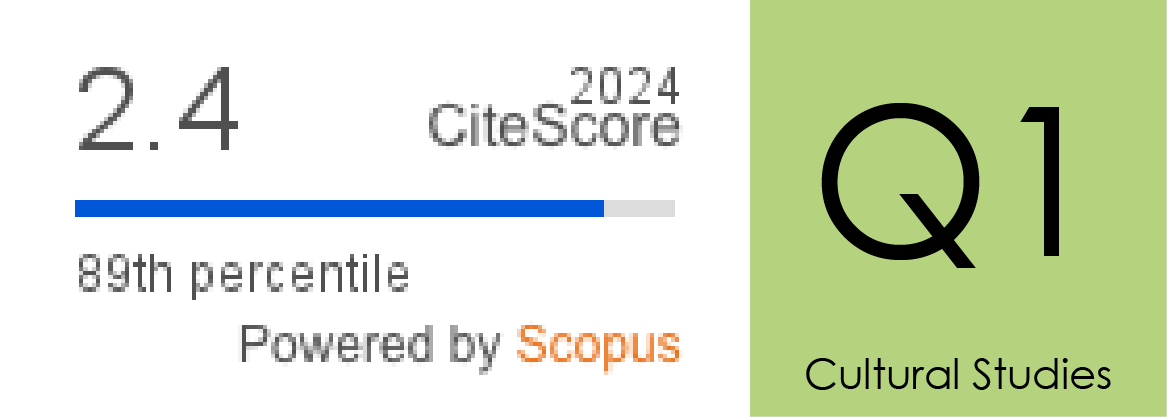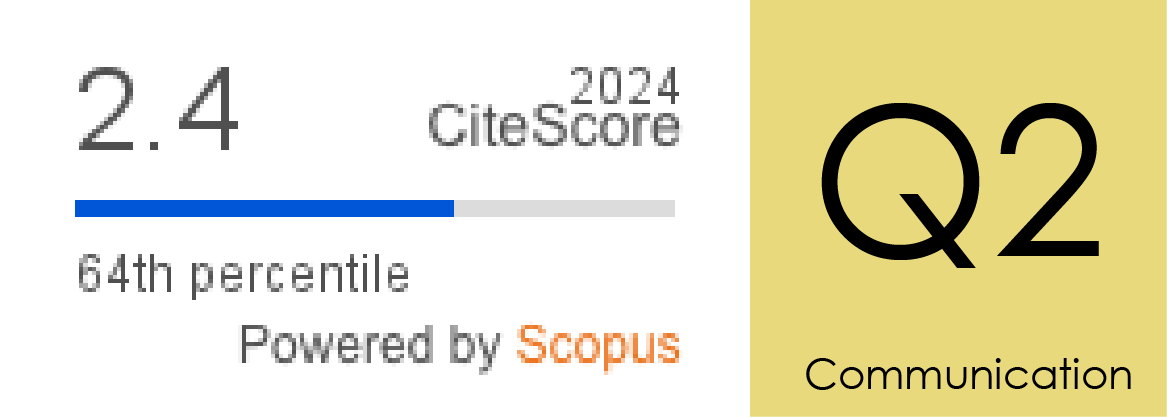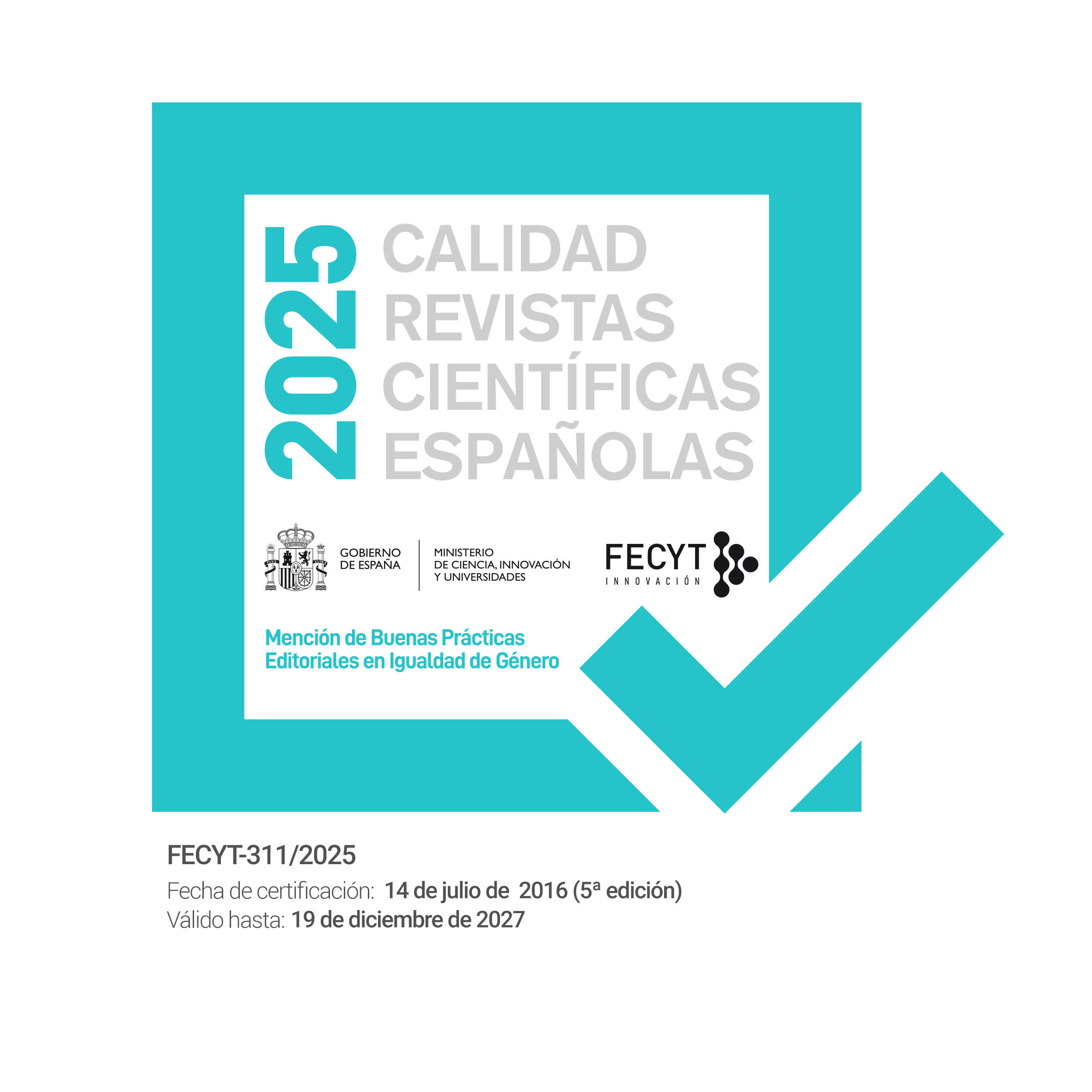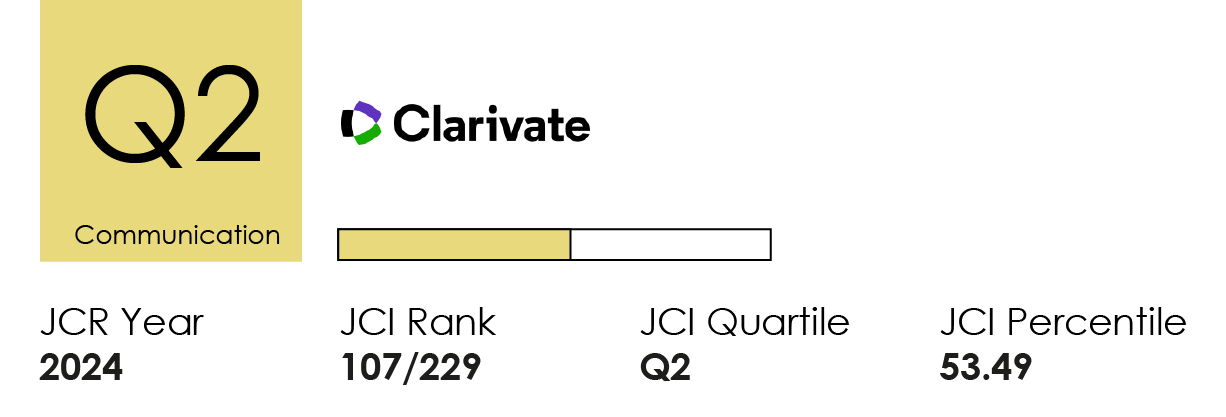Guerra Rusia-Ucrania. Difuminando los límites de las noticias: actualidad a través de perfiles en TikTok
DOI:
https://doi.org/10.14198/MEDCOM.25547Palabras clave:
Redes sociales, Guerra, Actualidad, TikTok, Géneros periodísticos, PeriodismoResumen
TikTok se ha convertido en un canal en el que la guerra de Rusia y Ucrania se retransmite casi en directo. La lógica de las redes sociales se hibrida con la lógica de los medios para ofrecer a los usuarios contenidos informativos que traspasan los límites de los medios tradicionales. Se estudia la evolución de la construcción y consumo de los vídeos sobre hechos de actualidad en TikTok. Se investigan los géneros periodísticos, los elementos audiovisuales y su finalidad en los vídeos publicados por perfiles anónimos, influencers, medios de comunicación y periodistas verificados en TikTok. Mediante análisis de contenido se decodifican 415 vídeos sobre la guerra entre ambos países durante 40 días (24/2/2022/5.04.2022). Se confirma que los perfiles anónimos e influencers se están apropiando de los géneros de los medios de comunicación tradicionales, y que los periodistas se están adaptando a los formatos propios de las redes sociales. El interés de la audiencia se centra en vídeos que no combinan elementos audiovisuales, sino que se decantan por vídeos con música sólo o sólo voz. En la finalidad no se detecta la hibridación de lógica de los medios de comunicación, por la falta de pluralidad y por el elevado uso de la emotividad, empleada principalmente por los influencers, y que es la que despierta más interés en la audiencia.
Financiación
Comunidad de Madrid y el Fondo Social EuropeoCitas
Abidin, C., Lee, J., Barbetta, T., & Miao, W. S. (2021). Influencers and COVID-19: reviewing key issues in press coverage across Australia, China, Japan, and South Korea. Media International Australia, 178(1), 114-135. https://doi.org/10.1177%2F1329878X20959838
Alp, Z. Z., & Öğüdücü, Ş. G. (2018). Identifying topical influencers on twitter based on user behavior and network topology. Knowledge-Based Systems, 141, 211-221. https://doi.org/10.1016/j.knosys.2017.11.021
Altheide, D. L. (2015). Media logic. In G. Mazzoleni, K. G. Barnhurst, & K. Ikeda (Ed.), The International Encyclopedia of political communication (pp. 1– 6). John Wiley & Sons.
Badham, M., & Mykkänen, M. (2022). A Relational Approach to How Media Engage With Their Audiences in Social Media. Media and Communication, 10(1), 54-65. https://doi.org/10.17645/mac.v10i1.4409
Barroso, J. (2002). Realización de los géneros televisivos. Síntesis.
Bell, E. J., Owen, T., Brown, P. D., Hauka, C., & Rashidian, N. (2017). The Platform Press: How Silicon Valley Reengineered Journalism. Tow Center for Digital Journalism. https://doi.org/10.7916/D8R216ZZ
Bentivegna, S., & Marchetti, R. (2018). Journalists at a Crossroads: Are Traditional Norms and Practices Challenged by Twitter? Journalism: Theory, Practice & Criticism, 19(2), 270–290. https://doi.org/10.1177/1464884917716594
Boy, B., Bucher, H. J., & Christ, K. (2020). Audiovisual science communication on TV and YouTube. How recipients understand and evaluate science videos. Frontiers in Communication, 5, 608620. https://doi.org/10.3389/fcomm.2020.608620
Bruns, A. (2018). Gatewatching and news curation: Journalism, social media, and the public sphere (Digital Formations, 113). Peter Lang Publishing.
Bulovsky, A. (2019). Authoritarian communication on social media: The relationship between democracy and leaders’ digital communicative practices. International Communication Gazette, 81(1), 20-45. https://doi.org/10.1177/174804851876779
Campbell, C., & Farrell, J. R. (2020). More than meets the eye: The functional components underlying influencer marketing. Business Horizons, 63(4), 469-479. http://dx.doi.org/10.1016/j.bushor.2020.03.003
Cebrián Herreros, M. (1992). Géneros informativos audiovisuales. Ciencia 3.
Cetina Presuel, R., & Martínez Sierra, J. (2019). Algorithms and the News: Social Media Platforms as News Publishers and Distributors. Revista de Comunicación, 18(2), 261-285. https://doi.org/10.26441/RC18.2-2019-A13
Chadwick, A., Dennis, J., & Smith, A. P. (2016). Politics in the age of hybrid media: Power, systems, and media logics. In Bruns, A., Enli, G., Skogerbø, E., Larsson, A. O., & Christensen, C. (Ed), The Routledge companion to social media and politics (pp. 7-22). Routledge.
Chayka, K. (03/03/2022). Watching the World’s “First TikTok War”. The New Yorker. https://tinyurl.com/mt47r9zt
Colomina, C. (30/01/2023). La guerra de Ucrania en TikTok. Barcelona Centre for International Affairs.
Colussi, J., & Rocha, P. M. (2020). Examining the journalistic genres hybridisation in content published by newspapers on Facebook live. The Journal of International Communication, 26(1), 20-35. https://doi.org/10.1080/13216597.2020.1744467
Deuze, M. (2017). Considering a possible future for Digital Journalism. Revista Mediterránea de Comunicación/Mediterranean Journal of Communication, 8(1), 9-18. https://www.doi.org/10.14198/MEDCOM2017.8.1.1
Ekström, M., & Westlund, O. (2019). The dislocation of news journalism: A conceptual framework for the study of epistemologies of digital journalism. Media and Communication, 7(1), 259–270. https://doi.org/10.17645/mac.v7i1.1763
Eldridge II, S. A., García-Carretero, L., & Broersma, M. (2019). Disintermediation in social networks: Conceptualizing political actors’ construction of publics on Twitter. Media and Communication, 7(1), 271-285. https://doi.org/10.17645/mac.v7i1.1825
Facchinetti, R. (2021). News discourse and the dissemination of knowledge and perspective: From print and monomodal to digital and multisemiotic. Journal of Pragmatics, 175, 195-206. https://doi.org/10.1016/j.pragma.2021.01.015
Gil de Zúñiga, H., & Cheng, Z. (2021). Origin and evolution of the News Finds Me perception: Review of theory and effects. Profesional de la información, 30(3), e300321. https://doi.org/10.3145/epi.2021.may.21
Harcup, T., & O’Neill, D. (2017). What is News?. Journalism Studies 18(12), 1470–1488. https://doi.org/10.1080/1461670X.2016.1150193
Hase, V., Boczek, K., & Scharkow, M. (20/10/2022). Adapting to Affordances and Audiences? A Cross-Platform, Multi-Modal Analysis of the Platformization of News on Facebook, Instagram, TikTok, and Twitter. Digital Journalism, 1-22. https://doi.org/10.1080/21670811.2022.2128389
Hellmueller, L., Vos, T. P., & Poepsel, M. A. (2013). Shifting journalistic capital? Transparency and objectivity in the twenty-first century. Journalism Studies, 14(3), 287–304. https://doi.org/10.1080/1461670X.2012.697686
Hendrickx, J. (2021). The Rise of Social Journalism: An Explorative Case Study of a Youth-oriented Instagram News Account. Journalism Practice, 1-16. https://doi.org/10.1080/17512786.2021.2012500
Hermida, A., & Mellado, C. (2020). Dimensions of social media logics: Mapping forms of journalistic norms and practices on Twitter and Instagram. Digital Journalism, 8(7), 864–884. https://doi.org/10.1080/ 21670811.2020.1805779
Hjarvard, S. (2018). Public service in the age of social network media. In G. F. Lowe, H. Van den Bulck, & K. Donders (Eds), Public Service Media in the Networked Society: RIPE@2017 (pp. 59-74). Nordicom, University of Gothenburg.
Hudíková, Z., Pravdová, H., & Gažicová, A. (2020). The pragmatism of hybridisation logic of television news in Slovakia. Communication Today, 11(1). https://bit.ly/3DHT4Sr
Huxley, K. (2020). Content analysis, quantitative. SAGE Publications Limited.
Johansson, E. (2019). Social media in political communication: a substitute for conventional media? In K. M. Johansson, & N. Gunnar (Eds.), Close and Distant: Political Executive–Media Relations in Four Countries, (pp. 149-173). Nordicom, University of Gothenburg.
Kalogeropoulos, A., Cherubini, F., & Newman, N. (2016). The future of online news video. Digital News Project. https://ssrn.com/abstract=2882465
Karnowski, V., Leiner, D. J., Sophie Kümpel, A., & Leonhard, L. (2021). Worth to share? How content characteristics and article competitiveness influence news sharing on social network sites. Journalism & Mass Communication Quarterly, 98(1), 59-82. https://doi.org/10.1177/1077699020940340
Kim, S. H., Carvalho, J. P., Davis, A. G., & Mullins, A. M. (2011). The view of the border: News framing of the definition, causes, and solutions to illegal immigration. Mass Communication and Society, 14(3), 292-314. https://doi.org/10.1080/15205431003743679
Klinger, U., & Svensson, J. (2014). The emergence of network media logic in political communication: A theoretical approach. New media & society, 17(8), 1241-1257. https://doi.org/10.1177/1461444814522952
Klinger, U., & Svensson, J. (2015). Network media logic. In A. Bruns, G. Enli, E. Skogerbø, A. O. Larsson, & C. Christensen (Eds), The Routledge companion to social media and politics (pp. 23–38). Routledge.
Klinger, U., & Svensson, J. (2018). The end of media logics? On algorithms and agency. New Media & Society, 20(12), 4653-4670. https://doi.org/10.1177/1461444818779750
Kreft, J., Boguszewicz-Kreft, M., & Hliebova, D. (2023). Under the Fire of Disinformation. Attitudes Towards Fake News in the Ukrainian Frozen War. Journalism Practice, 1-21. https://doi.org/10.1080/17512786.2023.2168209
Krippendorff K. (2011). Agreement and information in the reliability of coding. Penn Libraries. http://repository.upenn.edu/asc_papers/43
Kunze, K. N., Vadhera, A., Purbey, R., Singh, H., Kazarian, G. S., & Chahla, J. (2021). Infographics are more effective at increasing social media attention in comparison with original research articles: an altmetrics-based analysis. Arthroscopy: The Journal of Arthroscopic & Related Surgery, 37(8), 2591-2597. https://doi.org/10.1016/j.arthro.2021.03.056
Laurell, C., & Söderman, S. (2018). Sports, storytelling and social media: a review and conceptualization. International Journal of Sports Marketing and Sponsorship, 3(19), 338-349. https://doi.org/10.1108/IJSMS-11-2016-0084
Lee, Y. J. (2022). Language learning affordances of Instagram and TikTok. Innovation in Language Learning and Teaching, 1-16. https://doi.org/10.1080/17501229.2022.2051517
Lewis, R. (2020). “This is what the news won’t show you”: YouTube creators and the reactionary politics of micro-celebrity. Television & New Media, 21(2), 201-217. https://doi.org/10.1177%2F1527476419879919
Liao, S. (2019). “# IAmGay# What About You?”: Storytelling, Discursive Politics, and the Affective Dimension of Social Media Activism against Censorship in China. International Journal of Communication, 13(21), 2314–2333.
Lischka, J. A. (2021). Logics in social media news making: How social media editors marry the Facebook logic with journalistic standards. Journalism, 22(2), 430-447. https://doi.org/10.1177/1464884918788472
Lund, N. F., Scarles, C., & Cohen, S. A. (2020). The brand value continuum: Countering co-destruction of destination branding in social media through storytelling. Journal of Travel Research, 59(8), 1506-1521. https://doi.org/10.1177/00472875198872
Maares, P., & Hanusch, F. (2020). Exploring the boundaries of journalism: Instagram micro‐bloggers in the twilight zone of lifestyle journalism. Journalism, 21(2), 262–278. https://doi.org/10.1177/1464 884918801400
Makhortykh, M., & Bastian, M. (2022). Personalizing the war: Perspectives for the adoption of news recommendation algorithms in the media coverage of the conflict in Eastern Ukraine. Media, war & conflict, 15(1), 25-45. https://doi.org/10.1177/1750635220906254
Martin, F. R. (2021). Visibility, connectivity, agency: Journalism’s prospects in an age of automated social news sharing. Digital Journalism, 9(8), 1190-1198. https://doi.org/10.1080/21670811.2021.1977670
Martín, T., & Vázquez, B. C. (2022). La influencia de Instagram en la creación y reproducción del ideal de belleza femenino. Anuario Electrónico de Estudios en Comunicación Social "Disertaciones", 15(1). https://doi.org/10.12804/revistas.urosario.edu.co/disertaciones/a.11148
Martínez-Sanz, R., Buitrago, Á., y Martín-García, A. (2023). Comunicación para la salud a través de TikTok. Estudio de influencers de temática farmacéutica y conexión con su audiencia. Revista Mediterránea de Comunicación/Mediterranean Journal of Communication, 14(1), 83-98. https://www.doi.org/10.14198/MEDCOM.23435
Miller, J. H. (2021). The Abc's of News. Xlibris Corporation.
Moreno, J., & Sepúlveda, R. (2021). Article 13 on social media and news media: disintermediation and reintermediation on the modern media landscape. Communication & Society, 34(2), 141-157. https://doi.org/10.15581/003.34.2.141-157
Mueller, J., & Stumme, G. (2017). Predicting rising follower counts on Twitter using profile information. In Proceedings of the 2017 ACM on Web Science Conference (pp. 121-130). https://doi.org/10.1145/3091478.3091490
Muslikhin, M., Mulyana, D., Hidayat, D. R., & Utari, P. (2021). The commodification, spatialization and structuration of social media in the Indonesian cyber media news. Media and Communication, 9(2), 110-118. https://doi.org/10.17645/mac.v9i2.3752
Neumayer, C. (2022). Content, Form, and Reception: Perspectives from Digital Media Data. In P. Vossen, & A. Fokkens (Eds), Creating a More Transparent Internet: The Perspective Web (pp. 143-155). Cambridge University Press.
Newman, N. (08/12/2022). How publishers are learning to create and distribute news on TikTok. Reuters Institute for the Study of Journalism. https://tinyurl.com/yt2hrpns
Newman, N., Fletcher, R., Eddy, K., Robertson, C., & Nielsen, R. (2023). Reuters Institute digital news report 2023. Reuters Institute for the Study of Journalism. https://tinyurl.com/y48vxs53
Newman, N., Fletcher, R., Robertson, C., Eddy, K., & Nielsen, R. (2022). Reuters Institute digital news report 2022. Reuters Institute for the Study of Journalism. https://tinyurl.com/bd85j97b
Newman, N., Fletcher, R., Schulz, A., Andi, S., Robertson, C. T., & Kleis Nielsen, R. (2021). Digital news report 2021. Reuters Institute for the Study of Journalism.
Nygren, G., Glowacki, M., Hök, J., Kiria, I., Orlova D. & Taradai, D. (2018) Journalism in the Crossfire. Journalism Studies, 19(7), 1059-1078. https://doi.org/10.1080/1461670X.2016.1251332
Omar, B., Al-Samarraie, H., & Wright, B. (2020). Immediacy as news experience: exploring its multiple dimensions in print and online contexts. Online Information Review, 45(2), 461-480. https://doi.org/10.1108/OIR-12-2019-0388
Parry, K. (2019). Quantitative Content Analysis. The SAGE Handbook of Visual Research Methods.
Pavlik, J. V. (2022). The Russian war in Ukraine and the implications for the news media. Athens Journal of Mass Media and Communications, 8, 1-17. https://doi.org/10.30958/ajmmc.X-Y-Z
Peña-Fernández, S., Larrondo-Ureta, A., & Morales-i-Gras, J. (2022). Current affairs on TikTok. Virality and entertainment for digital natives. Profesional de la información, 31(1), e310106. https://doi.org/10.3145/epi.2022.ene.06
Pérez-Guerra, L. E., y Gómez-Navas, J. S. (2020). Influencers como generadores de opinión pública: un análisis cualitativo de Crudo Ecuador. En J. I. Aguaded Gómez, y A. Vizcaíno Verdú (Eds), Redes sociales y ciudadanía: hacía un mundo ciberconectado y empoderado (pp. 135-143). Grupo Comunicar.
Perreault, G., Perreault, M. F., & Maares, P. (2022). Metajournalistic discourse as a stabilizer within the journalistic field: Journalistic practice in the covid-19 pandemic. Journalism Practice, 16(2-3), 365-383. https://doi.org/10.1080/17512786.2021.1949630
Shoemaker, P. J. (2020). Gatekeeping and journalism. In Oxford Research Encyclopedia of Communication. https://doi.org/10.1093/acrefore/9780190228613.013.819
Sidorenko-Bautista, P., Herranz de la Casa, J. M., & Cantero de Julián, J. I. (2020). Use of New Narratives for COVID-19 reporting: from 360º videos to ephemeral TikTok videos in online media. Tripodos, 1(47), 105-122. http://hdl.handle.net/10578/26040
Springer, N., Nygren, G., Widholm, A., Orlova, D., & Taradai, D. (2022). Narrating" Their War" and" Our War"-the Patriotic Journalism Paradigm in the Context of Swedish and Ukrainian Conflict Coverage. Central European Journal of Communication, 21, 178-201. https://doi.org/10.51480/1899-5101.15.2(31).1
Stern, S. O., Tuckett, D., Smith, R. E., & Nyman, R. (2018). Measuring the influencers in the news media's narratives. In 2018 IEEE/ACM International Conference on Advances in Social Networks Analysis and Mining (ASONAM) (pp. 698-701). IEEE. https://tinyurl.com/yj28hf8a
Stiekolshchykova, V., Savchuk, R., Makarchuk, O., Filatenko, I., Humanenko, O., & Shoturma, N. (2022). Influential Modifications of the Genre System of Modern Mass Media. Postmodern Openings, 13(2), 461-474. https://doi.org/10.18662/po/13.2/465
Strömbäck, J., & Karlsson, M. (2011). WHO'S GOT THE POWER? Journalists’ perceptions of changing influences over the news. Journalism Practice, 5(6), 643-656. https://doi.org/10.1080/17512786.2011.592348
Suárez-Álvarez, R., & García-Jiménez, A. (2021). Centennials on TikTok: type of video. Analysis and comparative Spain- Great Britain by gender, age, and nationality. Revista Latina de Comunicación Social, 79, 1-22. https://www.doi.org/10.4185/RLCS-2021-1503
Tamir, D. I., & Jason, P. M., (2012). Disclosing Information about the Self is Intrinsically Rewarding. Proceedings of the National Academy of Sciences, 109(21), 8038–8043. https://doi.org/10.1073/pnas.1202129109
Thurman, N., Moeller, J., Helberger, N., & Trilling, D. (2019). My friends, editors, algorithms, and I: Examining audience attitudes to news selection. Digital journalism, 7(4), 447-469. https://doi.org/10.1080/21670811.2018.1493936
TikTok. (2023). Cuentas verificadas en TikTok. https://tinyurl.com/y287nanj
Tisdell, C., & Loch, B. (2016). How useful are closed captions for learning mathematics via online video? International Journal of Mathematical Education in Science and Technology, 48(2), 229-243. https://doi.org/10.1080/0020739X.2016.1238518
Törnberg, P., & Uitermark, J. (2022). Tweeting ourselves to death: the cultural logic of digital capitalism. Media, Culture & Society, 44(3), 574-590. https://doi.org/10.1177/01634437211053766
Tsuriel, K., Dvir Gvirsman, S., Ziv, L., Afriat-Aviv, H., & Ivan, L. (2021). Servant of two masters: How social media editors balance between mass media logic and social media logic. Journalism, 22(8), 1983-2000. https://doi.org/10.1177/1464884919849417
Van Dijck, J., & Poell, T. (2013). Understanding social media logic. Media and communication, 1(1), 2-14. https://doi.org/10.12924/mac2013.01010002
Van Krieken, K. (2018). Multimedia storytelling in journalism: Exploring narrative techniques in Snow Fall. Information, 9(5), 123. https://doi.org/10.3390/info9050123
Vázquez-Herrero, J., Direito-Rebollal, S., & López-García, X. (2019). Ephemeral journalism: News distribution through Instagram stories. Social Media+ Society, 5(4). https://doi.org/10.1177/2056305119888657
Vázquez-Herrero, J., Negreira-Rey, M.-C., & López-García, X. (2022). Let’s dance the news! How the news media are adapting to the logic of TikTok. Journalism, 23(8), 1717-1735. https://doi.org/10.1177/1464884920969092
Villi, M., & Picard, R. G. (2019). Transformation and innovation of media business models. In M. Deuze, & M. Prenger (Ed), Making media. Production, practices, and professions (pp. 121-131).
Wahl-Jorgensen, K. (2020). An Emotional Turn in Journalism Studies?. Digital Journalism, 8(2), 175–194. https://doi.org/10.1080/21670811.2019.1697626
Welbers, K., & Opgenhaffen, M. (2019). Presenting news on social media. Digital journalism, 7(1), 45-62. https://doi.org/10.1080/21670811.2018.1493939
Wölker, A., & Powell, T. E. (2021). Algorithms in the newsroom? News readers’ perceived credibility and selection of automated journalism. Journalism, 22(1), 86-103. https://doi.org/10.1177/1464884918757072
Yarlott, W. V., Cornelio, C., Gao, T., & Finlayson, M. (2018). Identifying the discourse function of news article paragraphs. In Proceedings of the Workshop Events and Stories in the News 2018 (pp. 25-33). https://aclanthology.org/W18-4304.pdf
Zulli, D., & Zulli, D. J. (2022). Extending the internet meme: Conceptualizing technological mimesis and imitation publics on the TikTok platform. New Media & Society, 24(8), 1872-1890. https://doi.org/10.1177/1461444820983603
Descargas
Estadísticas
Publicado
Cómo citar
Número
Sección
Licencia
Derechos de autor 2024 Antonio García-Jiménez, Rebeca Suárez-Álvarez, Beatriz Catalina-García

Esta obra está bajo una licencia internacional Creative Commons Atribución 4.0.
Los autores y autoras que publican en esta revista están de acuerdo con los siguientes términos:
1 Derechos de autor. Los autores y autoras conservan sus derechos de autor, aunque ceden a la revista de forma no exclusiva los derechos de explotación (reproducción, distribución, comunicación pública y transformación) y garantizan a esta el derecho de primera publicación de su trabajo, el cual estará simultáneamente sujeto a la licencia indicada en punto 2. Los autores pueden establecer otros acuerdos adicionales para la distribución no exclusiva de la versión de la obra publicada en la revista, siempre que exista un reconocimiento de su publicación inicial en esta revista.
© Los autores.
2 Licencia. Los trabajos se publican en la revista sujetos a la licencia de Reconocimiento 4.0 Internacional de Creative Commons (CC BY 4.0); los términos se pueden consultar en https://creativecommons.org/licenses/by/4.0/
Esta licencia permite a terceros compartir (copiar y redistribuir el material en cualquier medio o formato) y adaptar (remezclar, transformar y crear a partir del material para cualquier finalidad, incluso comercial), siempre que se reconozca la autoría y la primera publicación en esta revista (Revista Mediterránea de Comunicación (RMC) / Mediterranean Journal of Communication (MJC), Universidad de Alicante, DOI de la obra), se proporcione un enlace a la licencia y se indique si se han realizado cambios en la obra.
3 Política de autoarchivo. Se recomienda a los autores que difundan sus trabajos a través de Internet para favorecer una circulación y difusión más rápidas y, con ello, un posible aumento en la citación y alcance entre la comunidad científica y académica, en las siguientes condiciones:
No se permite a los autores depositar en un repositorio institucional o temático, página web propia, etc., las versiones preprint (versión antes de ser evaluada) o postprint (versión evaluada y aceptada para su publicación) de sus trabajos antes de su publicación, pero sí el artículo final publicado (versión del editor).













